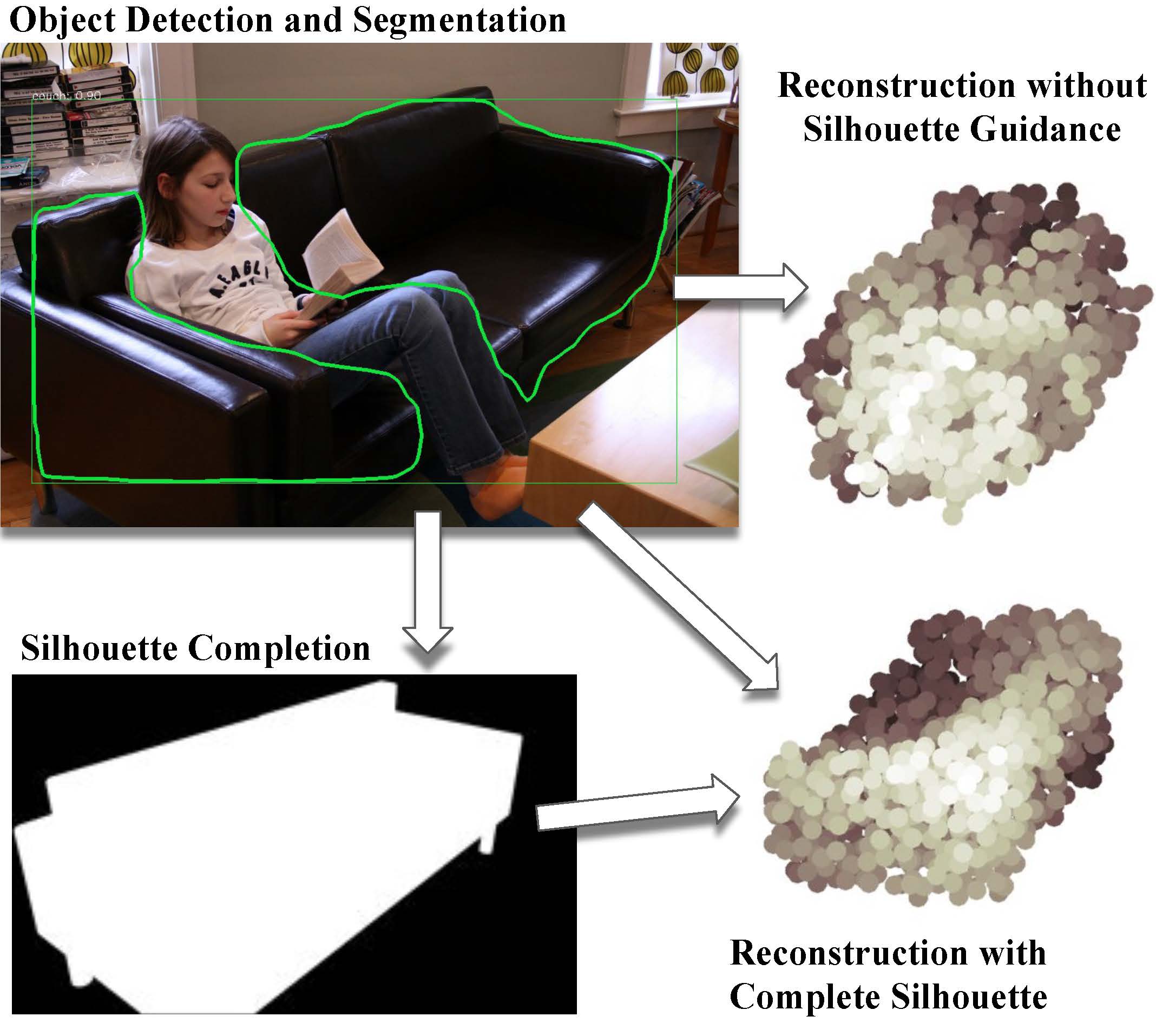Silhouette-Guided-3D
PyTorch implementation of our WACV 2020 paper: "Silhouette Guided Point Cloud Reconstruction beyond Occlusion"
Our short introduction video
Network architecture:
Requirements
- Python 3
- PyTorch >= 0.4.0
- numpy, scipy, pickle, skimage, sklearn, random, re
- torchvision
- Matlab (for FSSR based post process)
Installation
- Install mve by following the instructions. This is for FSSR based point cloud refinement.
- Under ./matlab folder, install gptoolbox for Matlab based Poisson-Disc Sampling
- [Optional] Install Pix3D evaluation toolkit under the current folder. Note that this requires Tensorflow.
- [Optional] Install PCN evaluation toolkit under the current folder. Note that this requires Tensorflow. PCN toolkit is for object-centered evaluation.
- [Optional] Install Mask-RCNN benchmark under the current folder. This is for getting visible silhouette for completion in Pix3D (We've included pre-processed results as below).
Download Data and Pre-trained Model
- Download pre-trained models and put them under the ./model/ folder.
- Download pre-processed DYCE dataset and put them under the ./data/ folder.
- Download pre-processed Pix3D dataset and put them under the ./data/ folder. This includes pre-computed complete silhouette and ground truth point clouds rotated w.r.t. camera position. We've excluded examples with incorrect Mask-RCNN detections.
- Download ShapeNet dataset and put them under the ./data/ folder.
- Download pre-processed LSUN dataset and put them under the ./data/ folder
- Download pre-computed result. and put them under the ./result/ folder. This includes point clouds prediction on ShapeNet and Pix3D after FSSR refinement.
- [Optional] Download ShapeNet rendered images, and put them under ./data/ShapeNet/ folder. This is for comparing to object-centered point cloud reconstruction approach.
- [Optional] Download ShapeNet object-centered point cloud ground truth, , and put them under ./data/ShapeNet/ folder. This is for comparing to object-centered point cloud reconstruction approach.
Training
-
Point cloud reconstruction
python train.py python test.pyThis will save network predictions for the downstream FSSR post-refinement step.
-
Silhouette completion First train on DYCE dataset:
python train_sc.pyThen finetune on Pix3D dataset, using 5-fold cross validation ( you will need to run it 5 times by changing the fold number in L32-35 ):
python train_sc_ft.py python test_sc_pix3d.py -
Silhouette guidede point cloud reconstruction
python train_occ.py python test_rec_pix3d.pyThen perform FSSR post-refinement step as describe below
Surface Based Point Clouds Refinement
- Start matlab
cd matlab ./matlab - pre-compute FSSR params (per-pixel normal and scale), change folder name based on your saved network predictions path
FssrPostRefine - FSSR
Here we provide the sample batch-process code (need to go back to the main folder):
cd .. python fssr_batch_process.py - smoothing
This produces the refined point clouds for evaluation.
cd matlab preComputeFssrParam cd ..
Evaluation
- Pix3D
- ICP-based fitting since Pix3D ground truth is object-centered (you can skip this step since we've included pre-computered ground truth and predictions). Code is derived from 3D-LMNET, which also includes the ground truth point cloud.
cd pcn python metrics_pix3d.py cd .. - You need to use TensorFlow 3.0+ to run the evaluation:
cd pix3d/eval/ python eval_pix3d.py cd ../../
- ICP-based fitting since Pix3D ground truth is object-centered (you can skip this step since we've included pre-computered ground truth and predictions). Code is derived from 3D-LMNET, which also includes the ground truth point cloud.
- ShapeNet
- You need to use TensorFlow 3.0+ to run the evaluation:
cd pcn python eval_shapenet.py cd .. - To compare with object-centered point cloud prediction appraoch (3D-LMNET), you need to perform ICP-based fitting first:
cd pcn python metrics_shapenet.py cd ../pix3d/eval/ python eval_shapenet_object_centered.py cd ../../
- You need to use TensorFlow 3.0+ to run the evaluation:
- DYCE (silhouette completion)
- This is PyTorch based
python test_sc_DYCE.py
- This is PyTorch based
Citation
Please cite our paper for any purpose of usage.
@inproceedings{zou2020silhouette,
title={Silhouette Guided Point Cloud Reconstruction beyond Occlusion},
author={Zou, Chuhang and Hoiem, Derek},
booktitle={The IEEE Winter Conference on Applications of Computer Vision},
pages={41--50},
year={2020}
}

